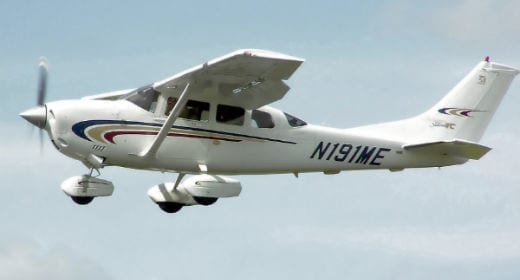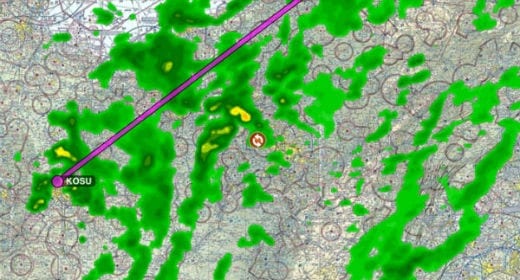
Those photo missions – smile!
LogbooksHaving a photo mission go as planned and result in a formation flight with another airplane (or two or three) as the sun rose or set put the participants in a place of serene beauty and it was rewarding to share that with our readers and viewers. It was a thought that I often had, but on some of those flights I knew I had the best job in the world.

Night flight
I was thereIt had been one of those perfect fall days, a day when you could see forever. The light had a clarity one only sees in the fall, and then only rarely. It was the kind of light that painters dream of. The night was still, without even the whisper of a breeze.

Using historical weather data to learn
Weather GeekAs pilots, we spend a lot of time reviewing the weather before a flight--you might even say some pilots obsess about it. But very few pilots spend any time looking at the weather after a flight. That's a shame, because there's much to learn from a post-flight analysis and there are some new tools that make it quite easy.

Shifting snow and the point of no return
I was thereSo I taxied to the threshold following a “Follow Me” jeep as I could not see the taxiway. Meanwhile my Flight Commander went to the tower to watch. Maybe he expected a spectacle – but as it happened he gave me good advice and by all accounts he got a spectacle too!

The trip to Dong Den Mountain
HistoryLuxury hotels line the idyllic beach today. Forty-eight years ago, it was a bare sugar white expanse of sand and surf and the site of our crude Marine Corps helicopter base known as Marble Mountain Air Facility just east of Da Nang by the South China Sea. Our Marine CH-46 helicopter squadron had flown ashore ten days earlier.

An evening alone
I was there“Lights, camera, action!” I recite to no one but me. It’s my final mantra before takeoff in my Cavalier. Nav and strobe lights on, transponder to ALT, and power up to go. Gladys, my instructor, taught me that.

A Thanksgiving cross-country adventure
I was thereI was excited at the opportunity to complete a real cross-country trip with my wife to visit family in Tennessee for the Thanksgiving holiday. For weeks prior to the trip, I passed the time planning the flight and picking out the best fuel stops. The plan was finally set. Preflight inspection now complete, we were ready to fly!

Is the ADS-B glass half full?
John's blogOver the past 25 years, pilots have complained about three different transponder rules: Mode C, then Mode S and now ADS-B. Is the FAA really this incompetent or do pilots just like to gripe? As usual, the answer is a little bit of both. I say the ADS-B glass is half full.

Four Merlins to Momote
HistoryIn this current era of over-regulation, it may seem, understandably to anyone reading this story now, that we were a bunch of over-enthusiastic young men with little sense of professional responsibility. But it was another time and things were different then. For this ancient airman, they were the good old days and I mourn their passing.

Why I bought a Pig!
I was thereIn my last article I told you what it took to get my wife in the air. As much as that short flight over La Jolla (San Diego) was fun, the goal was always, and forever will be, to use the airplane for family flying. So after years of airport hopping, $100 burger runs (by myself I might add), and oh so many touch and goes, it was time to take the family on a real trip.

Don’t take anything for granted!
I was thereSince I began taking flying lessons, about 5 years ago, our dream was to fly to Fort Collins. I mean, after endlessly flying over the featureless flatlands of the Midwest, how cool to see the freakin’ Rocky Mountains filling your windshield!

From the archives: Dick Collins on airline vs. GA flying
Air Facts ArchivesIn our latest trip through the Air Facts archives, we discovered this gem from the April 1965 issue. Here, a young Richard Collins considers the advantages and disadvantages of traveling on the airlines versus flying oneself by light airplane. Is it really worth it to fly instead of ride? Nearly 50 years later, many pilots are still asking the question--Collins answers it definitively.

Welcome to the war
Veterans' StoriesIn March 1967, as I finished my first year as a draftee in the Army, I kissed my wife good-bye in Tulsa and flew to San Francisco to go to war. At Travis, we boarded a chartered DC-8 airliner for the flight to Vietnam.

Those pilot reports – of the magazine variety
LogbooksOver my 50 years in the print magazine business I would estimate that I wrote at least 300 pilot report features plus a lot of other airplane coverage in columns. I started to go back and count exactly how many there were but decided that wouldn’t be any fun. Instead, I’ll tell you about some that were different enough for me to vividly remember.

No time for prayer: surviving catastrophic engine failure
I was thereBefore the engine blew, it was making a repetitive cyclical type noise; it wasn’t high pitched, it was kind of like the sound of a card flapping on a set of bicycle spokes, going fairly rapidly, getting painfully louder and louder to the point it seemed like my headset was not muffling the noise at all as the big end of the number 2 rod broke and the piston was beaten against the crank case.

Hungry Pilot: the Hangar Hotel Airport Diner
The Hungry PilotAirport Diner may not be a creative name, but this diner is far from ordinary. Right next to the famous Hangar Hotel in Fredericksburg, Texas, pilots flock to this restaurant for big breakfasts and great milkshakes.

Why I wear a ball cap when I fly
OpinionIt started blue, a dark blue, when my wife gave it to me as a Christmas present. Its latest achievement of many was earned in March when I completed my CFI training. It was instrumental in keeping my head from exploding while learning in flight, and during the check ride. Now my two-tone AOPA ball cap has faded to a light purple from long periods of exposure to the sun.

Old pilots never die – they can stick around for years
I was thereOur drop mission was weather-dependent. It required smooth conditions in a layer up to 1500 ft above ground, to stay below radar, with at least a minimum off-shore breeze of 10 knots. The drop had to be done half an hour before sunset in cloudless, though not necessarily clear, conditions. In fact, a little obscuring haze up-sun would help the stealth nature of the task.

2500 miles of value-added flying
I was thereCan general aviation really be used for transportation? This pilot says yes, and a recent trip from Seattle to Wisconsin proves just how effectively it can be done. It was 30% less travel time than the airlines, and a lot more fun.

Go or No Go: fall cold front
Go or No GoAs you stare at your iPad in the pilots' lounge at Rochester, New York, you find yourself wishing for the warm days of summer. Your plan tonight is to fly from your business meeting in Rochester (ROC) to your home outside Columbus, Ohio (OSU). Will the weather cooperate?
